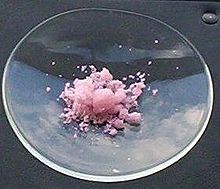Erbium(III) chloride

| |
| Names | |
|---|---|
| IUPAC name
Erbium(III) chloride
| |
| Other names
Erbium trichloride
| |
| Identifiers | |
| |
3D model (JSmol)
|
|
| ChemSpider | |
| ECHA InfoCard | 100.030.337 |
PubChem CID
|
|
| UNII | |
CompTox Dashboard (EPA)
|
|
| |
| |
| Properties | |
| ErCl3 (anhydrous) ErCl3·6H2O (hexahydrate) | |
| Molar mass | 273.62 g/mol (anhydrous) 381.71 g/mol (hexahydrate) |
| Appearance | violet hygroscopic monoclinic crystals (anhydrous) pink hygroscopic crystals (hexahydrate) |
| Density | 4.1 g/cm3 (anhydrous) |
| Melting point | 776 °C (1,429 °F; 1,049 K) (anhydrous) decomposes (hexahydrate) |
| Boiling point | 1,500 °C (2,730 °F; 1,770 K) |
| soluble in water (anhydrous) slightly soluble in ethanol (hexahydrate)[1] | |
| Structure[2] | |
| monoclinic | |
| C2/m, No. 12 | |
a = 6.80 Å, b = 11.79 Å, c = 6.39 Å α = 90°, β = 110.7°, γ = 90°
| |
Lattice volume (V)
|
479 Å3 |
Formula units (Z)
|
4 |
| Related compounds | |
Other anions
|
Erbium(III) oxide |
Other cations
|
Holmium(III) chloride, Thulium(III) chloride |
Except where otherwise noted, data are given for materials in their standard state (at 25 °C [77 °F], 100 kPa). | |
| Infobox references | |
Erbium(III) chloride is a violet solid with the formula ErCl3. It is used in the preparation of erbium metal.
Properties[]

It is also found as a pink crystalline hexahydrate, CAS number [10025-75-9]. It has the interesting property that the pink colour is much more intense under light from a fluorescent lamp, as may be seen from the picture.
Anhydrous erbium(III) chloride is formed from the hexahydrate by heating under a strongly chlorinating atmosphere, such as chlorine or hydrogen chloride; otherwise , ErOCl, is formed. An alternative preparation is to react the readily available Er2O3 with excess NH4Cl to make the intermediate salt (NH4)3ErCl6 plus both ammonia and water. This salt is stable with respect to hydrolysis and can be thermally decomposed under vacuum to yield anhydrous erbium(III) chloride with loss of ammonia and gaseous HCl.
It reacts with alkalis to form erbium(III) hydroxide:
- ErCl3 + 3 MOH → Er(OH)3 + 3 MCl
Structural data[]
Erbium chloride forms crystals of the AlCl3 type, with monoclinic crystals and the point group C2/m.[2]
Erbium(III) chloride hexahydrate also forms monoclinic crystals with the point group of P2/n (P2/c) - C42h. The erbium is octa-coordinated to form [Er(H2O)6Cl2]+ ions with the isolated Cl− completing the structure.[3]
Optical properties[]
Erbium(III) chloride solutions show a effect.[4]
Catalytic properties[]
The use of erbium(III) chloride as a catalyst has been demonstrated in the acylation of alcohols and phenols[5] and in an amine functionalisation of furfural.[6] It is a catalyst for Friedel–Crafts-type reactions, and can be used in place of cerium(III) chloride for Luche reductions.[7]
References[]
- ^ Lide, David R. (1998). Handbook of Chemistry and Physics (87 ed.). Boca Raton, Florida: CRC Press. pp. 4–57. ISBN 0-8493-0594-2.
- ^ a b Tempelton DH, Carter GF (1954). "The Crystal Structure of Yttrium Trichloride and Similar Compounds". J Phys Chem. 58 (11): 940–943. doi:10.1021/j150521a002.
- ^ Graebner EJ, Conrad GH, Duliere SF (1966). "Crystallographic data for solvated rare earth chlorides". Acta Crystallographica. 21 (6): 1012–1013. doi:10.1107/S0365110X66004420.
- ^ Maeda Y, Akidzuki Y, Yamada T (1998). "All-optical liquid device derived from negative nonlinear absorption effect in an erbium chloride solution". Applied Physics Letters. 73 (17): 2411–2413. doi:10.1063/1.122450.
- ^ Dalpozzo Renato, De Nino Antonio, Maiuolo Loredana, Oliverio Manuela, Procopio Antonio, Russo Beatrice, Tocci Amedeo (2007) Erbium(iii) Chloride: a Very Active Acylation Catalyst. Australian Journal of Chemistry 60, 75-79. doi:10.1071/CH06346
- ^ Synthesis of trans-4,5-Bis-dibenzylaminocyclopent-2-enone from Furfural Catalyzed by ErCl3·6H2O Mónica S. Estevão, Ricardo J. V. Martins, and Carlos A. M. Afonso Journal of Chemical Education 2017 94 (10), 1587-1589 {DOI|10.1021/acs.jchemed.6b00470}
- ^ Luche, Jean-Louis (2001-04-15), "Erbium(III) Chloride", in John Wiley & Sons, Ltd (ed.), Encyclopedia of Reagents for Organic Synthesis, Chichester, UK: John Wiley & Sons, Ltd, pp. re006, doi:10.1002/047084289x.re006, ISBN 978-0-471-93623-7
- Erbium compounds
- Chlorides
- Lanthanide halides